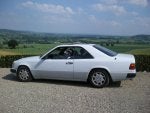I gave the pressurized system more than an hour and I did not see any leaks. I disconnected the CSV fuel line at the fuel distributor and gasoline was under pressure. ...
It’s not about the question whether there
is residual pressure after the system has been pressurized … it’s about the question to
what level the pressure drops when the hot engine is switched off and at
what level it still is 30 minutes later.
Besides, like checking the duty cycle, testing the fuel pressure (system ~, lower chamber ~, holding ~), is a standard procedure for troubleshooting the KE-Jetronic and a lot easier than people usually think. Complete fuel pressure tests, also covering acceleration enrichment and overrun cut-off, can be done within less than an hour (passively observing the manometer during the ‘holding pressure’ test taking most of that time) ... and they can supply a lot of information about many KE-Jetronic components.
I agree with MBL about ethanol. Especially if the car isn’t used much, ethanol containing fuel can be problematic with the time. Not only can it increase carbon deposit forming, but it also bears risks for KE-Jetronic components.
And these carbon deposits on the backside of the intake valves and in the intake ports are not only often the reason for starting problems … also the engine’s running behavior, particularly at idle, can be affected. The mixture of atomized fuel and air passing metalic bright surfaces is more homogeneous compared to it passing carbon clad surfaces.
And not only does the engine consume more fuel if it contains ethanol in order to deliver the same performance due to its lower energy content, but also Lambda control requires a richer air/fuel mixture. With non-ethanol fuel the stoichiometric mixture is about 14.7:1 … with pure ethanol it’s about 9:1. … If this leads to thinking, that that must have an influence on the duty cycle … you’re right! :wink_2:
I talked in more detail about several things regarding ethanol containing fuel’s effect on the KE-Jetronic (including its effect on the duty cycle) in this thread:
http://www.benzworld.org/forums/w12.../forums/w126-s-se-sec-sel-sd/2720049-ke-jetronic-lambda-control-duty-cycle.html
H.D.





